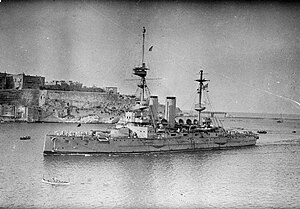 HMS London entering Malta Harbour in 1915
| |
| History | |
|---|---|
| Name | HMS London |
| Builder | Portsmouth Dockyard |
| Laid down | 8 December 1898 |
| Launched | 21 September 1899 |
| Completed | June 1902 |
| Commissioned | 7 June 1902 |
| Decommissioned | January 1919 |
| Fate | Broken up, 1922 |
| General characteristics | |
| Class and type | London-class battleship |
| Displacement | |
| Length | 431 ft 9 in (131.6 m) o/a |
| Beam | 75 ft (22.9 m) |
| Draught | 26 ft (7.9 m) |
| Installed power |
|
| Propulsion | |
| Speed | 18 knots (33 km/h; 21 mph) |
| Complement | 714 |
| Armament |
|
| Armour | |
HMS London was the lead ship of the London class of pre-dreadnought battleships built for the British Royal Navy. The Londons were near repeats of the preceding Formidable-class battleships, but with modified armour protection. The ship was laid down in December 1898, was launched in September 1899, and was completed in June 1902. Commissioned the same month, she served with the Mediterranean Fleet until early 1907. She was assigned to the Nore Division of the Home Fleet for nearly a year before transferring to the Channel Fleet. Rendered obsolete with the emergence of the new dreadnoughts in late 1906, she underwent an extensive refit in 1909, after which she served with the Atlantic Fleet. She was assigned to the Second Home Fleet in 1912 as part of the 5th Battle Squadron, and was temporarily fitted with a makeshift ramp for experiments with naval aircraft until 1913.
Following the outbreak of the First World War, the squadron was attached to the Channel Fleet before London was detached in March 1915 to participate in the Dardanelles Campaign, supporting ANZAC forces as they landed at Gaba Tepe and Anzac Cove on 25 April 1915. She remained in the Mediterranean, supporting the Italian Royal Navy in the Adriatic Sea until October 1916. Returning to the United Kingdom, she was inactive until being converted to a minelayer in early 1918, which entailed the removal of her main armament. She served with the Grand Fleet's 1st Minelaying Squadron until the end of the war. Placed in reserve in 1919, she was eventually broken up for scrap in 1920.